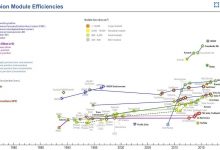America’s National Renewable Energy Laboratory, which regularly publishes a chart of the world’s most efficient solar cells, earlier this month introduced a new chart of record-efficiency solar modules.
And – as you can see in the inaugural Champion Module Efficiencies chart below, Australia’s own University of New South Wales is a star performer.
As the NREL explains, the chart (which you can click on to enlarge) contains 73 data points, dating back to 1988, and divided into 19 different technologies.
“The records range from an organic photovoltaic (PV) module with an 8.2 percent efficiency that was developed by Toshiba to a 40.6 percent efficient hybrid four-junction module from the University of New South Wales.”
As we have noted on RE before, it’s easy to forget in these days of cheap and abundant solar that there are still teams of researchers working tirelessly to make the technology even cheaper and more efficient.
UNSW has been leading the global solar R&D pack for decades now, and just last December announced a big deal with a Chinese specialist PV manufacturer to fast-track the mass production of “next generation” PERC solar cells.











